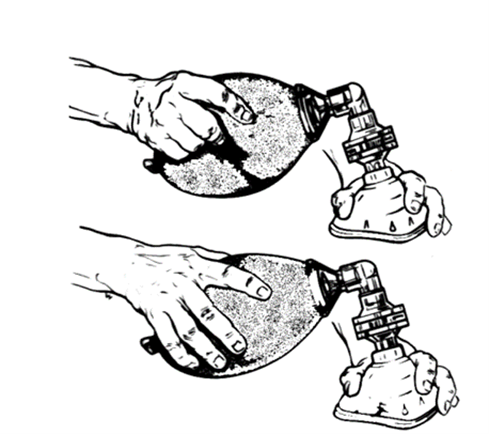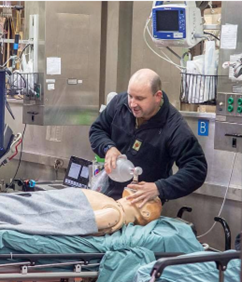1.1 Manual Resuscitators and Manual Ventilation
Bag Valve Mask (BVM)
Respiratory therapists must understand manual resuscitators and manual ventilation. They must not only how to use them, but also when to use them. In addition, they must be able to troubleshoot any problems that may arise.
A bag valve mask (BVM), commonly known as a “bag” or “ambu bag,” is a handheld device used in emergency situations for patients who are not breathing (respiratory arrest) or who are not breathing adequately (respiratory failure). See Figure 1.[1] This device is different from the other oxygen devices because it assists with ventilation, the movement of air into and out of the lungs, as well as oxygenation.

Self-inflating bag valve masks are produced in different sizes for infants, children, and adults to prevent lung injury, so it is important to use the correct size for the patient. When using a self-inflating bag mask valve, the rescuer manually compresses the bag to force air into the lungs. Squeezing the bag once every 5–6 seconds for an adult or once every 3 seconds for an infant or child provides an adequate respiratory rate. In inpatient settings, the bag mask valve is attached to an oxygen supply to increase the concentration of oxygenation provided with each breath. Self-inflating bags can be used with or without oxygen and must be squeezed in order to deliver oxygen to the patient.
Flow-inflating bags also come in different sizes, but unlike a self-inflating bag, the flow-inflating bag requires a constant flow of oxygen into the bag, and you must maintain a good seal with the mask. Otherwise, the bag deflates. Flow-inflating bags are typically used in anesthesia and pediatric units because they offer better control of pressure and volume delivered to the patient. A clinician can also easily feel lung compliance and resistance when compressed.
View the following supplementary YouTube video[2] that demonstrates the difference between self-inflating bags and flow-inflating bags: 5-3. Self-Inflating Bags vs. Free Flow Inflating Bags
It is vital to obtain a tight seal of the mask to the patient’s face, but this is difficult for a single rescuer to achieve. Therefore, two rescuers are recommended; one rescuer performs a jaw thrust maneuver, secures the mask to the patient’s face with both hands, and focuses on maintaining a leak-proof mask seal, while the other rescuer squeezes the bag and focuses on the amount and the timing.
Flow Rate: The flow rate for a bag valve mask attached to an oxygen source should be set to 15 L/min, resulting in FiO2 of approximately 100%.
Advantages: A bag valve mask is portable and provides immediate assistance to patients in respiratory failure or respiratory arrest. It also can be used to hyperoxygenate patients before procedures that can cause hypoxia, such as tracheal suctioning. These can also be used with or without a gas source.
Disadvantages: The rate and depth of compression of the bag must be closely monitored to prevent injury to the patient. In the event of respiratory failure when the patient is still breathing, the bag compressions must be coordinated with the patient’s inhalations to ensure that oxygen is delivered, and asynchrony of breaths is prevented. Complications may also result from overinflating or overpressurizing the patient. Complications include lung injury or the inflation of the stomach that can lead to aspiration of stomach contents. Additionally, rescuers may tire after a few minutes of manually compressing the bag, resulting in less-than-optimal ventilation. Alternatively, an endotracheal tube (ET) can be inserted by an advanced practitioner to substitute for the mask portion of this device.
Below are the proper techniques for operating a bag valve mask:
- Select the appropriate size mask and bag for the patient.
- Connect the BVM to oxygen at a flow rate of 15 L/min.
- If available, attach a filter to the exhaust port to reduce the spread of COVID and other airborne infectious diseases.
- Place the patient in the supine position on a firm surface.
- Position yourself at their head with your shoulders square with the patient.
- Place the mask in your nondominant hand.
- Use your thumb and index finger in “C” technique (see Figure 2[3]). Be sure to keep your fingers on the hard plastic to create a good face seal. Place the nose of the mask on the bridge of the patient’s nose.
- Lower the mask over the patient’s mouth.
- Using the middle, ring, and pinky finger in the “E” technique, along the bottom of the jawbone, lock your elbow and lean back, bringing the patient’s face “up” into the mask (see Figure 3[4]).
- In your dominant hand, hold the oxygen bag out to the side of the patient.
- With the head remaining tilted into the sniffing position, gently squeeze the bag until you see the chest rise. The goal is to deliver each breath over 1 second to minimize gastric distention or lung trauma. Deliver breaths for an adult once every 5–6 seconds or children every 2–3 seconds.
- If resources exist, use a two-person BVM technique:
- One rescuer holds the mask with both hands in the “E / C” technique or thumb-down technique.
- The other rescuer squeezes the bag at the above-mentioned rates, just enough to see the chest rise.


- “Ballon ventilation 1.jpg” by Rama is licensed under CC BY-SA 2.0 FR ↵
- Mooncat Publications. (2017, October 31). 5-3. Self-Inflating Bags vs. Free Flow Inflating Bags [Video]. YouTube. All rights reserved. https://www.youtube.com/watch?v=lBmLm0g_4fM ↵
- “Resuscitator 3 - Operation (PSF).png” by Pearson Scott Foresman is in the Public Domain. ↵
- “49757385962_5a78324bc2_k” by Mass Communication Specialist 3rd Class Jake Greenberg, US Navy is in the Public Domain. The appearance of U.S. Department of Defense (DoD) visual information does not imply or constitute DoD endorsement. ↵

